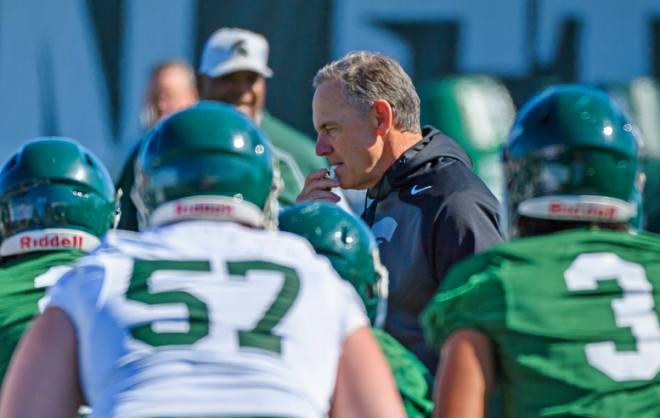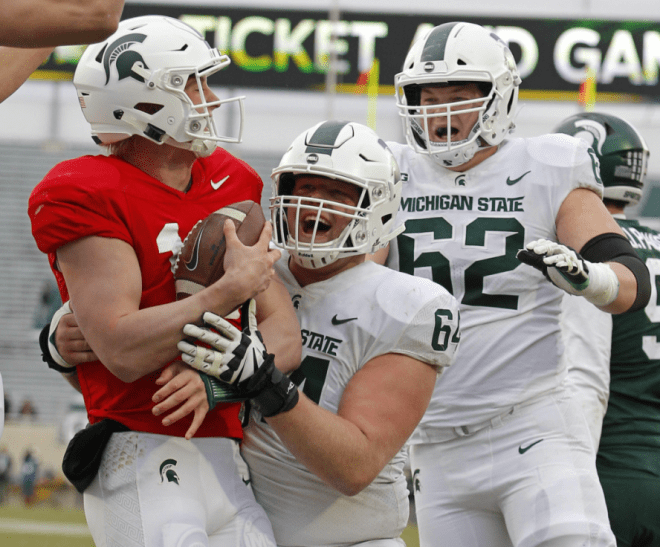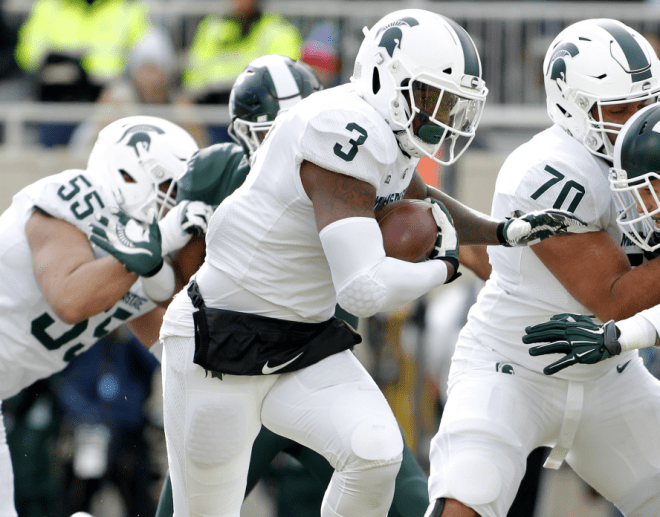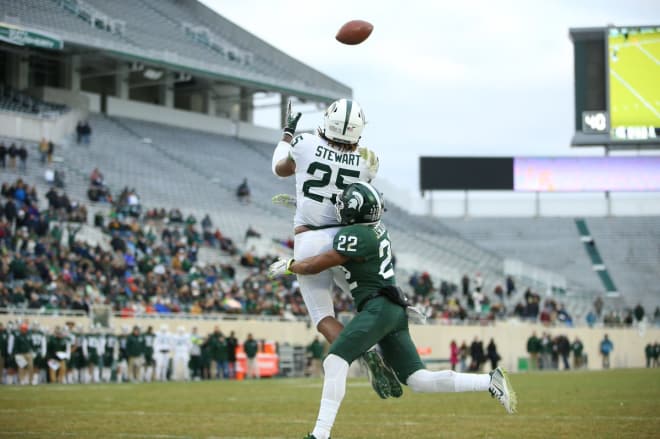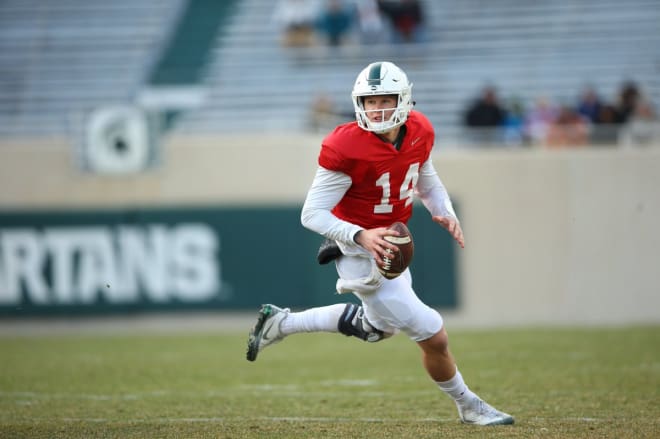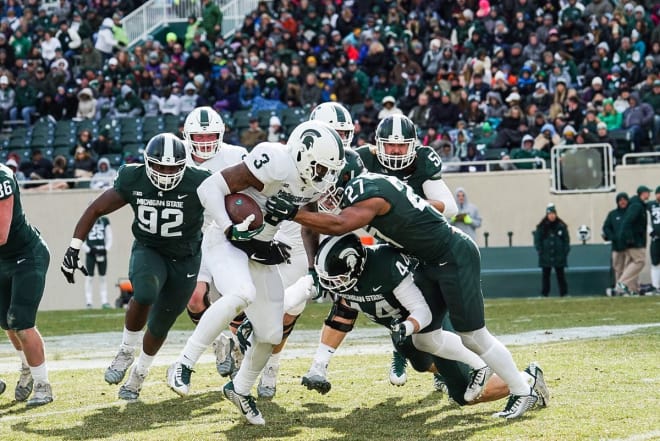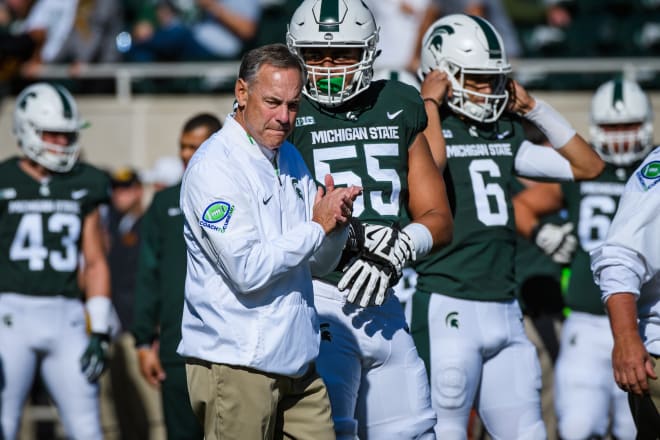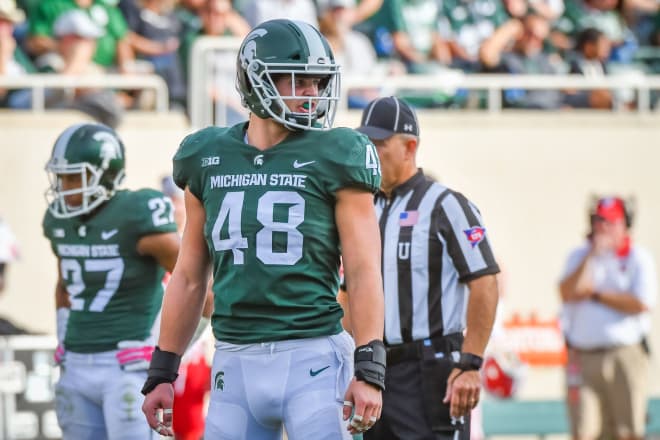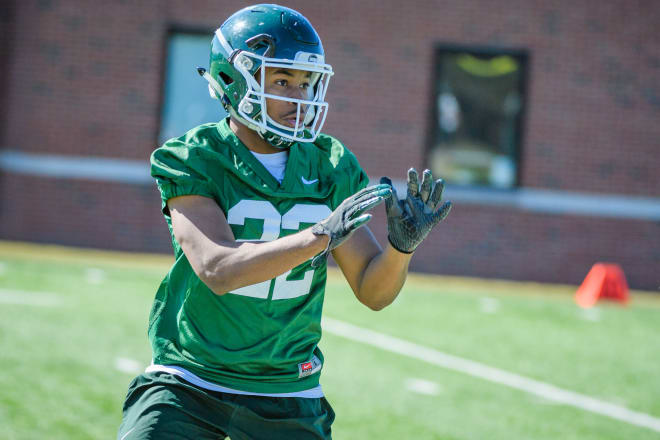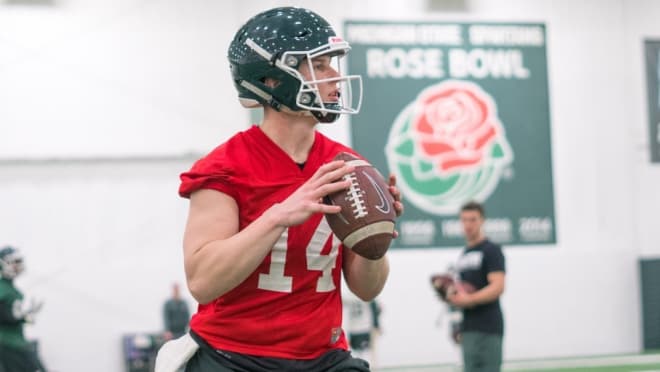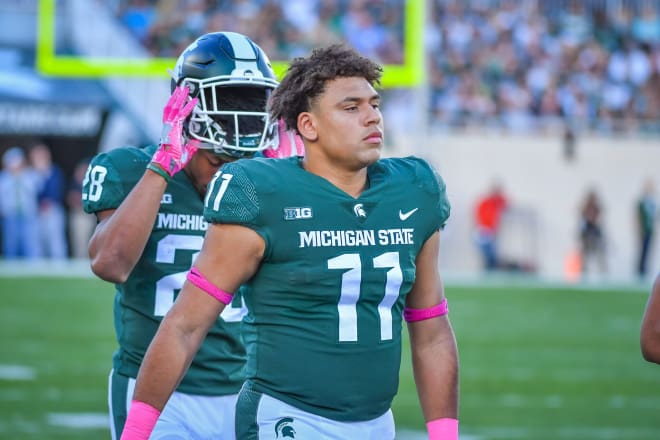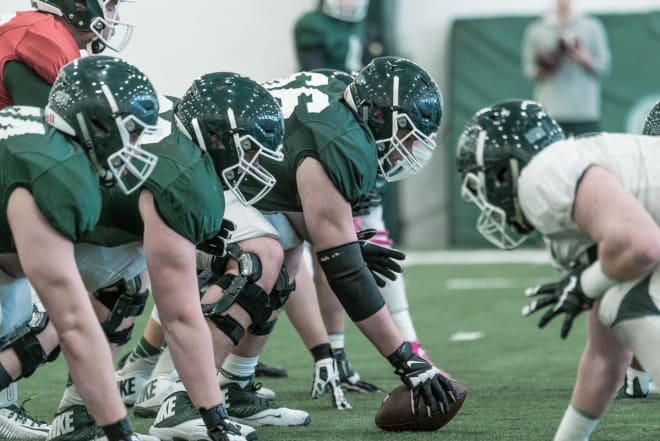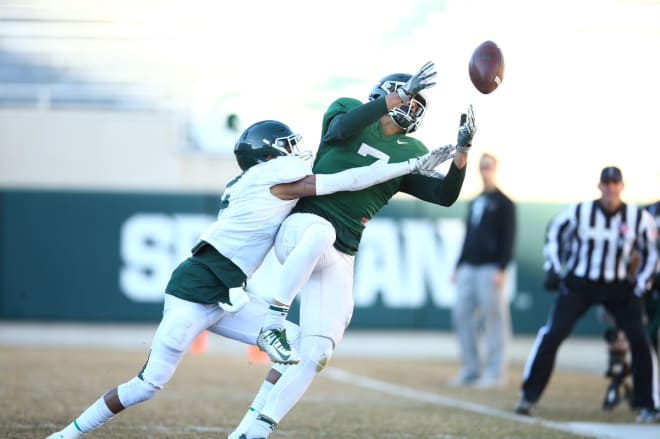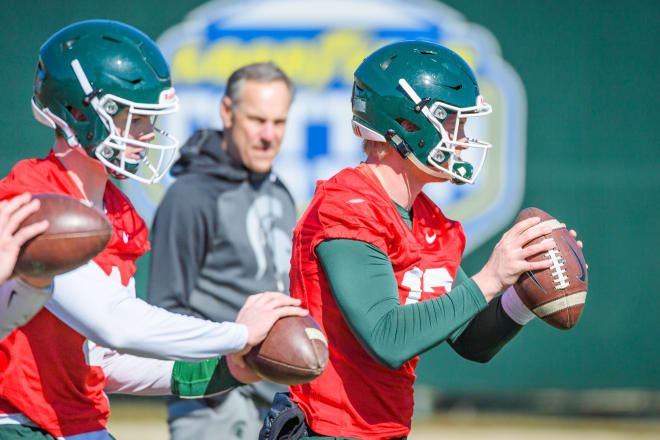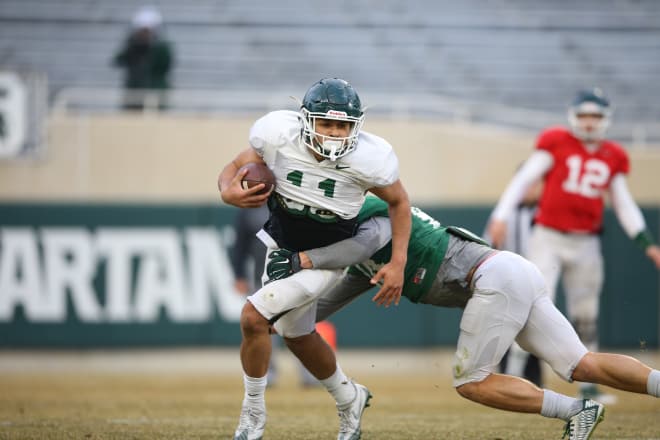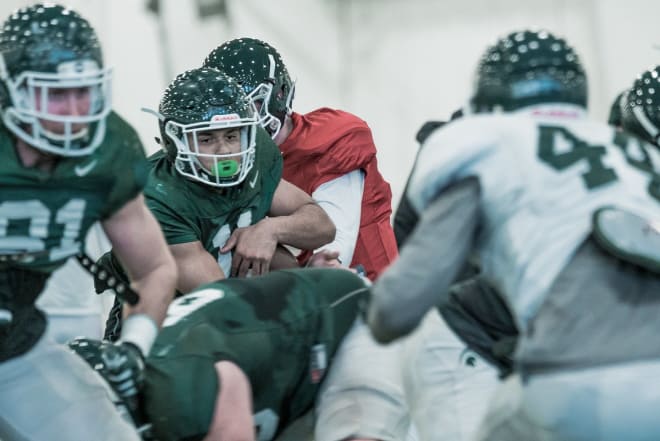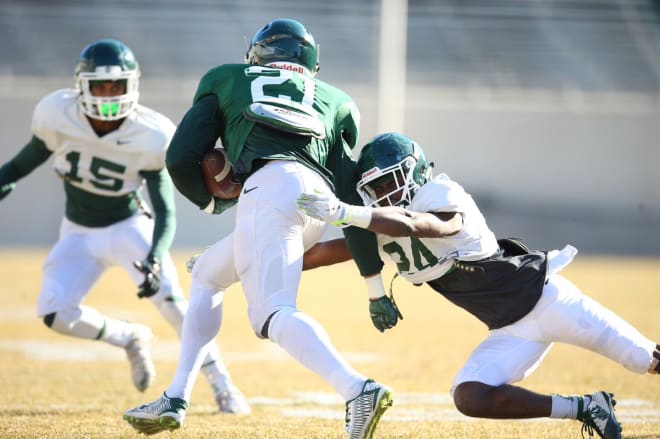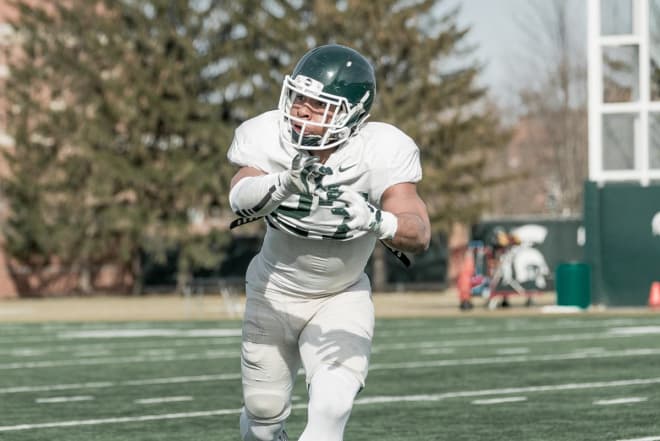Spring Football Report: The 3-2-1
Jim Comparoni • SpartanMag.com
@JimComparoni
EAST LANSING - Three things we’ve learned during the last week of spring practice, two questions and one prediction:
Disclaimer: It’s difficult to know for sure what’s going on in spring football, because we’re not allowed to watch much practice.
So we try to probe around and piece together information. So the following isn’t as concrete as things we might determine after watching a live game and film review. But it’s April, and any football talk is interesting football talk, in my opinion.
THREE THINGS (I THINK) WE’VE LEARNED:
1. I think there is great chemistry in the coaching rooms.
When
Mike Tressel talks about the value of having a former offensive coach like
Don Treadwell in the defensive film room, it’s sincere. There’s a value to having an offensive coach’s set of eyeballs bringing some insight into what past opponents have tried to do against MSU’s defense.
FBS programs were allowed to add a coach this season. I haven’t done a study on what other programs have chosen to do in terms of adding a staff member, but MSU’s hiring of Treadwell is an interesting one. Putting him on the defensive side of the ball to assist Paul Haynes in replacing Harlon Barnett is an interesting move. And
Mark Dantonio’s decision to create a new role in asking Treadwell to be “Head Coach” of the true freshmen is a throwback to the way things used to be when all freshmen were ineligible, and throw-forward to something that I think is needed with incoming players today.
Tom Izzo often talks about the challenges college athletes, and college students in general, have with social media. This week, we’ve seen Michigan State sophomore basketball player
Nick Ward publicly tweet his frustrations in the way some “fans” have sent him direct criticisms for his decision to test the NBA Draft waters.
Freshman college football players have immense adaptations to make during their first year on campus. They feel pressure from everywhere.
During the heat of a season, the assistant coach who recruited a true freshman and the position coach who is in charge of overseeing a true freshman, sometimes lose day-to-day contact with that freshman as he spends a year on the scout team. Coaching staff members have so many demands on their time, in terms of game-planning, watching film and getting their first- and second-stringers in order, that true freshmen sometimes are left floating in the wind a bit.
And I can’t help but notice that the occasional legal problems that Michigan State players have gotten into over the years seem to disproportionately involve first-year players. Think about it.
Donnie Corley, Josh King, Demetric Vance, Auston Robertson. All true freshmen. Going back to
Glenn Winston and his first arrest in 2008, and several of the allegations made in the ESPN Outside The Lines report, it’s been freshman after freshman.
Michigan State hasn’t had many problems in these areas over the years, in my opinion, despite the picture ESPN has tried to portray since January. But I think the designation of Treadwell as MSU’s freshman head coach is a smart, progressive, constructive move for Spartan football, and for the orientation of MSU’s incoming freshmen. Treadwell is a fatherly guy who has been a part of this program in the past, a person who knows Dantonio probably as well as anyone in the business, and a football man who has spent time as a head coach.
When Dantonio was asked about Treadwell on Tuesday, a broad smile came over Dantonio's face, and he spoke glowingly about a chat he had with Treadwell while jogging that day. They are two like minds, two like hearts. Treadwell knows and respects how Dantonio thinks, and Dantonio knows Treadwell will offer the right words and direction to freshmen this year - direction they haven't had in the past.
Treadwell has already started with that process.
“We have about seven rookies in now, entered early, so it gives you a chance to get to know those guys, whereas if you are just dealing with your position group, you may get to know some of them in due time,” Treadwell said. “But when your task is to make sure you get to know them, then it gives you a chance to broaden that support net that we have here. And we have great support here. We coach as a family.
“Yeah, we all have a position group, but we also communicate to one another. That will be a fun part becasue we get to see things on the field, to be able to share things as we evaluate them and we also get to know them as people. We are all mentors to a degree. I think that will be kind of an ongoing role.”
And then listen to
Paul Konyndyk’s interview with defensive tackles coach Ron Burton, when Burton is asked about working with new defensive ends coach Chuck Bullough. Burton’s expression and exuberance are unmistakable. It’s obvious that Burton likes tag-teaming with Bullough.
I’ve covered 29 seasons of Michigan State football, and I’ve seen coaching staffs changes many times, and have heard assistant coaches say good things about new arrivals on many occasions. But the chemistry and good vibes surrounding MSU’s new hires this year seems a cut above past experiences, from my vantage point.
Of course, none of that chemistry will mean much if the Spartans don’t produce on the field - especially on defense, where replacing Barnett will be a task.
As I said in a V-Cast earlier this spring, Barnett probably could not have left the defensive backfield in better shape. The secondary is filled with young, proven players - each with a high ceiling of potential to aspire to from this point forward.
As for the stamp that
Mike Tressel will put on this defense, that’s something we won’t possibly get a feel for until the pads start hitting in public in September. Even Saturday’s Green-White Game won’t reveal how Tressel will play his cards in the fall.
But it’s April. And we can wonder.
2. Things Are Physical.
I asked an offensive coach this week for his overall impressions for how things are going this spring. Aside from the general positives that you usually here from coaches, he said the defense, as a whole, has played with physicality.
We know the defense was good, statistically, last year, ranking No. 7 in the country in total defense.
And we know the defense should be better this year, with nine returning starters and 14 defensive players returning with starting experience.
Those veteran players are showing no signs of complacency. Instead, they are doing what you would expect them to do - they are maturing, and working to improve their technique. The result, according to the offensive coach I spoke with, has been a more physical version of those 14 players than you’ve seen in the past.
That sounds favorable, to me.
And it’s no surprise that the Michigan State defense has stymied the Spartan offense in the two spring Jersey Scrimmages thus far.
Saturday will mark the final meeting of the spring, and the most important one, in terms of measuring individual and collective progress.
3. The X-Factors Are Coming Through.
Connor Heyward has impressed teammates this spring.
At least that’s what I’m getting from our attempted detective work.
MSU’s question marks for the spring: defensive end, back-up quarterback, back-up tailback, center, tight end depth?
Michigan State seems to be making progress in all of these areas, with surprise gains being made in some places - namely
Justice Alexander at defensive end.
We’ve heard good things about Alexander from a few people in recent days and months, dating back to bowl practice. It continued through the first half of spring with teammates and assistant coaches saying good things about Alexander, who has been athletic but inconsistent up to this point in his career.
Then on Tuesday, Dantonio sounded off about Alexander.
“Justice Alexander is making progress, great progress,” Dantonio said. “He’s 6’5”, 260-265, long jumps 10-2, verticals 34-35, so I mean he’s finally starting to play fast and you see some good things from him.
“There’s a bunch of guys making moves.”
Among them: Redshirt freshman
Rocky Lombardi as the second-string quarterback;
Connor Heyward as the second-string running back;
Cam Chambers, rising into the wide receiver rotation as the fourth man; sophomore
Matt Dotson, as one of the top three tight ends.
* Brian Lewerke on Heyward: “I think he’s going to be a big part of the offense this year for sure. He’s one of the guys that is very good at seeing the hole and hitting it hard. He obviously likes to run over guys. That’s two big things that are good for him.”
* Lewerke on Dotson: "He’s very athletic, obviously tall. So you can kind of just throw the ball to him in the red zone which is advantageous for him, for sure."
* Tight ends coach
Jim Bollman on Dotson: "He knew that he needed to work on his blocking and improve on that, and he’s really doing a great job of doing that. He’s always been a very good runner and continues to improve on other parts of the game too."
* Offensive coordinator
Dave Warner on Chambers: "Cam Chambers has come on. He’s been playing all three positions. He’s done better than okay. he’s done very well for us this spring. He is one guy that I see moving up and fitting into the mix there."
One of the biggest questions remains who is going to become
Brian Allen’s successor at center? Sophomore
Matt Allen, junior
Tyler Higby and sophomore
Jordan Reid have been competing at center this spring.
Offensive line coach
Mark Staten says Reid is in good position to become a starter at some position. Will it be center? None of us knows at this point, and the players don’t know, either. Staten likes to keep them guessing, keep them working, keep them competing. But Reid, who saw time last year as a true freshman, appears to be improving as rapidly as anyone in the program right now.
As for Higby, it’s good that he is learning the center position, just to provide some manufactured depth and know-how along the front line.
“Playing center has helped me learn more about the line in general,” Higby said after practice on Thursday. “When you play center, you have to know what everyone else is doing, and their assignments on each play.”
He says that’s carried over in making him a better offensive guard. And this week in practice, Higby has dabbled at left tackle.
Higby began last season as a starter at left tackle, but eventually lost that starting job to David Beedle, due in part to some minor dings. Now, with spring reps at center at left tackle, if Higby doesn’t regain a starting job this fall, he is getting in position to be a valuable utility player at every position along the offensive line. That’s the type of quality depth that takes hold when the bottom 40, or “next” 40, of a program is strong.
TWO QUESTIONS
1. Can Lombardi Turn It Up?
Lombardi has played to good reviews in practice since August. On Saturday, he will play in front of a live audience at Spartan Stadium for the first time, and a nationwide BTN audience.
Defense has dominated the spring. Lombardi and true freshman
Theo Day have done some good things in the scrimmages thus far, but there have been some mistakes as well. So I’m intrigued to see how Lombardi finishes his first spring in East Lansing.
2. Will Justice Alexander Shine?
When they say he is playing well, I’m wondering how well? Is he merely functional? Or better than that?
Demetrius Cooper was functional last year. Michigan State needs something better than that, and I frankly didn’t expect Alexander to deliver, based on his lack of contributions in his first two years.
But all these good things we’re hearing about him makes me pause, and makes me curious as to just how “good” is good, when we’re talking about Alexander’s level of play.
We will see Alexander play some rush end and some boundary end. He and Kenny Willekes are both capable of playing both d-end positions.
We’ll see Alexander on the left side, and the right side, against the first string. That means, as long as everyone is healthy, we’ll see Alexander against proven offensive tackles likes
Cole Chewins and
Luke Campbell. We know Chewins and Campbell can block good Big Ten defensive ends. If Alexander defeats them a few times, I would chalk that down as a favorable occurrence.
In the past, I have not been impressed with Alexander’s ability, or inability, to turn the corner with speed and flexibility as a pass rusher. It’s usually difficult to gain aptitude in that area. It seems that some players either have that flexibility or they don’t.
Alexander can help at d-end even if he isn’t a great hoop-running edge guy. But if he surprises me and shows now capability in that area, then this Michigan State defense will become a bit more interesting for 2018.
ONE PREDICTION:
1. Kenny Willekes Will Play Big.
I just spent a bunch of paragraphs talking about Justice Alexander, and the good reviews he’s been playing to. But Willekes, a former walk-on who emerged as a surprise standout as a third-team All-Big Ten selection a year ago, has taken his game up yet another notch, from what I’ve heard. Good sources tell me he has gone from good to very good.
With that being the case, and the relentless, competitive motor that he plays with, I suspect he’ll have a noisy afternoon on Saturday.




























